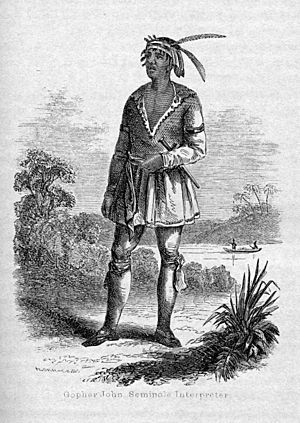Mascogos facts for kids
| Regions with significant populations | |
|---|---|
| Coahuila | |
| Languages | |
| Mexican Spanish, Afro-Seminole Creole | |
| Religion | |
| predominantly Catholic | |
| Related ethnic groups | |
| other Zambo groups |
The Mascogos (also called negros mascagos) are a group of people in Coahuila, Mexico. They are descendants of Afro-descendant people. Most of them live in the town of El Nacimiento in Múzquiz Municipality. The Mascogos are descendants of Black Seminoles who escaped the danger of slavery in the United States.
Contents
A Look Back: Mascogo History
After the Seminole Wars, the Seminole and Black Seminole people were forced to move from Florida. They went to a place called Indian Territory (which is now part of Oklahoma). A group of them, led by Seminole chief Wild Cat and Black Seminole chief John Horse, moved to northern Mexico.
They settled in El Nacimiento in 1852. The Mexican government hired them to help protect against attacks from other groups. Sadly, many Seminoles died from smallpox. Many of the remaining Seminoles and some Black Seminoles eventually went back to the United States.
In May 2017, the Governor of Coahuila, Rubén Moreira Valdez, made an important announcement. He signed a paper that officially recognized the tribu de los negros mascogos as an "indigenous people of Coahuila." This means they are now seen as one of the native groups of the state. The governor hoped the Mascogos would start getting help from the National Institute of Indigenous Peoples by 2018. He also shared that the history of the Mascogos, Kickapoo people, and Chinese immigrants is now taught in the state's history books.
Mascogo Culture and Traditions
The name "Mascogo" might come from the Muscogee language. A special part of their culture is the capeyuye. These are religious songs sung with hand clapping. They are performed at funerals, New Year's, and Christmas. In 2015, an album called Mascogo Soul was released. It featured four older Mascogo women singing capeyuye songs.
The Mascogos celebrate Juneteenth. This holiday marks the end of slavery in the United States. During the celebrations, family members and Black Seminoles from Brackettville, Texas, visit the community.
Traditional Mascogo Food
Mascogo traditional dishes are very tasty! They include:
- soske (a type of thick drink, like atole)
- tetapún (bread made from sweet potato)
- empanadas filled with pumpkin or piloncillo (a type of brown sugar)
- pan de mortero (a special bread)
Mascogo Clothing and Community
Mascogo women often wear a traditional outfit. It includes a long, polka-dotted dress, an apron, and a scarf tied around their head.
Over time, more Mascogos have married people from outside their community. This has changed the community's makeup. For example, Homero Vásquez, an older Mascogo man, shared that his mother was from Chihuahua. He said that starting in the 1930s, many farmers moved to the region. This led to more marriages with outsiders.
Many young people from El Nacimiento move to other parts of Mexico or the United States. They often do this because there are not enough job opportunities in their hometown. The Afro-Seminole Creole language is mainly used for the capeyuye songs. It is mostly spoken by the older people in the community.
See also
 In Spanish: Mascogos para niños
In Spanish: Mascogos para niños


